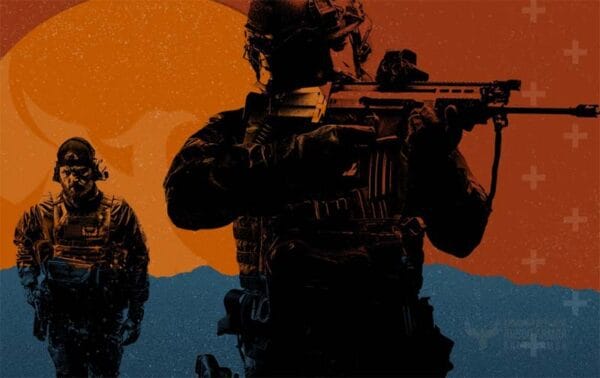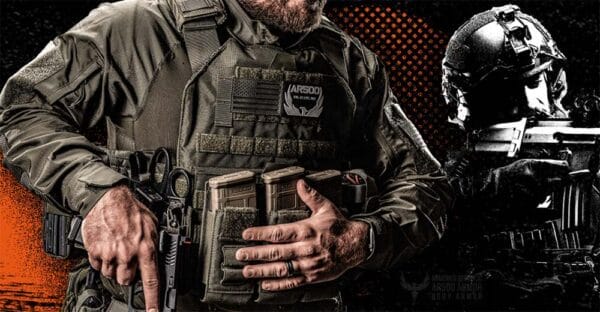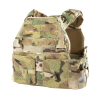This article is part of the Prepper Conversations Series.

Is this future coming soon to your neighborhood….?
In the dimly lit room of a suburban home in Baltimore, John Mitchell, a Navy veteran, meticulously inspected his gear. The news on television buzzed with reports of escalating conflict between various factions in Hamas and Israel. The world had changed, and the streets of America were no longer safe. John knew that preparation was the key to survival in this new world.
Body armor had become as essential as food and water. It wasn’t just for the military or law enforcement anymore. Civilians like John had recognized its importance, especially after the Boston Marathon bombing, the Las Vegas shooting, and the countless other incidents that had shaken the nation to its core.
John’s thoughts drifted back to missions in Iraq. He remembered the weight of his hard body armor, made of ceramic, as he moved through a hostile city. It had saved his life more than once, deflecting bullets and shrapnel from a nearby explosion.
But now, in civilian life, he preferred soft body armor. It was lighter and allowed for more mobility, essential for the urban jungle he now navigated. However, his complete armor kit was comprehensive. His plate carrier, a vest designed to hold armor plates, was adjusted to fit him snugly. He had front and rear armor plates, ensuring his vital organs were protected. Side plates, though not essential, provided that extra layer of security. The groin protector and trauma pad were additions he hoped he’d never have to rely on.
As he suited up, he remembered his military training. Awareness was crucial. He had to be constantly vigilant, ready to move swiftly to safety, using the environment to his advantage. Body armor wasn’t a magical shield; it had its limitations. But it was a line of defense that could mean the difference between life and death.
The world outside was unpredictable. Reports of armed criminals, dangerous flash mobs, and even rumors of foreign military-age invaders pouring across the border had become the norm. The term “SHTF” (Shit Hits The Fan) had moved from prepper forums to everyday conversations. In such scenarios, body armor was more than just protection; it was a private statement. A self-affirmation that you were prepared and wouldn’t be an easy target.
For those on a budget, soft body armor was a godsend. It was affordable and provided decent protection against most handguns. But for those who could afford it, like John, plate body armor was the way to go. It was a hefty investment, but the protection it offered against high-powered rifles was unmatched.

Body Armor Components:
- Soft body armor: Soft body armor is a lightweight and flexible alternative to hard body armor and is made of materials such as Kevlar, which can stop most handgun rounds.
- Plate carriers: Plate carriers are vests or harnesses that are used to hold armor plates in place. They can be either soft or hard, with soft plate carriers being more flexible and comfortable to wear, and more concealable, while hard plate carriers offer more protection and can carry more gear.
- Armor plates: Armor plates are the main protective component of body armor. They are typically made of steel, ceramic, or composite materials. Steel plates are the most durable and offer the most protection, but are also the heaviest. Ceramic plates are lighter than steel plates but offer less protection. Composite plates are a combination of steel and ceramic plates and offer a good balance of protection and weight.
- Side plates: Side plates are smaller armor plates that are inserted into the sides of a plate carrier to provide additional protection for the wearer’s flanks.
- Groin protectors: Groin protectors are worn to protect the wearer’s groin from injury. They are typically made of hard plastic or Kevlar.
- Trauma pads: Trauma pads are placed behind armor plates to absorb and disperse the energy from a bullet’s impact, reducing trauma. Trauma Pads are typically made of foam or rubber.
- Other components: Other common body armor components include shoulder pads, neck guards, and upper arm guards.
In addition to the components listed above, a variety of accessories are available for body armor, such as magazine pouches, hydration carriers, and first aid kits.
Live Inventory Price Checker
|
|
AR Freeman Plate Carrier with Armor Package | AR500 Armor | $ 124.00 |
|

|
Scarab Light Plate Carrier - Medium Plate Carrier, Black | Brownells.com | $ 309.00 |
|

|
DFNDR Armor QRC Plate Carrier - Ranger Green | Rainier Arms | $ 355.00 |
|
|
|
Ggg Minimalist Plate Carrier | Monstrum | $ 126.50 |
|

|
Queen Plate Carrier (QPC) - Women's Plate Carrier - Multicam | RMA Armament | $ 249.99 |
|
|
|
High Speed Gear Core Plate Carrier Large MultiCam Nylon | Ammunition Depot | $ 100.99 |
|
Tips for the Prepared:
- Blend In: Your armor should be your secret. Opt for concealable versions that don’t draw attention.
- Stay Mobile: Ensure your armor doesn’t restrict movement. You might need to move quickly in an urban environment.
- Maintenance is Key: Regularly inspect your armor for wear and tear. The urban jungle can be just as harsh as a battlefield.
- Knowledge is Power: Understand the capabilities and limitations of your armor. Not all threats are equal, and it’s essential to know what protection you have.
In this new world, survival wasn’t just about strength or skill but about preparation. And as John Mitchell moved through the streets of Baltimore, he knew he was ready for whatever lay ahead.
John stepped out of his house, the weight of his armor comforting. The streets were eerily quiet, but he knew that danger lurked around every corner. He moved with purpose, his senses heightened.
As he walked, he thought of his family, safely hidden away in a secure location. He was on a mission to get supplies and wouldn’t let anything stand in his way. The body armor was his guardian, a silent protector that he hoped would see him through the chaos.
More Resources:
Body Armor Basics, by Armored Republic
About Tred Law
Tred Law is your everyday patriot with a deep love for this country and a no-compromise approach to the Second Amendment. He does not write articles for Ammoland every week, but when he does write, it is usually about liberals Fing with his right to keep and bear arms.




Body armor isn’t really on the same tier as food and water. Once you make sure your house is in order on basic pillars then spread into armor. Physical fitness is required. It’s heavy, it’s hot, it’s uncomfortable at times and if you’re not used to those conditions then you will leave it sitting around. It’s also not going to be an all day every day thing. Your handgun shouldn’t be on it. It should be on the belt so when you drop the armor your still armed. Make sure everything is taken outta the plastic. Make sure you try… Read more »
In the 70’s and 80’s, I never wore body armor. Never worked at a department that issued it and I never had the money to buy my own. Life was good. In the 90’s. My last job issued and required that we wear it. I did not like it. It was uncomfortable. It retained body heat and perspiration. It was heavy and tended to slow you down in every way imaginable. You tired more easily when wearing it. It was a PITA to clean and have dried on your days off, before your next duty shift began. I was happier… Read more »
California liberals are terrified of body armor! The North Hollywood bank robbers routed these liberals.
The information here is pretty interesting, and I enjoyed the thoughts. It seems not to require a militarily trained mind to be able to recognize the fairly basic ideas presented (any mind with a bit of training would suffice), so the novelistic view into his specialized thinking seems a little overdone. A simple, documentary presentation here might delightfully skip the anti-climactic melodrama that suggests a profundity of insights beyond what is present. Not a complaint, but perhaps a useful suggestion. I’m also wondering how, with plate armor being John’s way to go, one walks around Baltimore with such a vest… Read more »
Fits most. So, 6 ft 3 man 370 lbs. with a 62 inch waist is good?
Too much of a good thing could result in a real life recreation of the main character’s little brother in “A Christmas Story”. Some kind of careful balance between critical freedom of movement and ballistic protection will likely be necessary. If you end up so well protected that you can’t hardly move you might have created another problem every bit as critical. 🙂
I CAN’T PUT MY ARMS DOWN!
Wow, a recycle of an article from 1 year ago. I guess there is nothing new in the news that is important enough to write about like maybe terrorists burning down electric vehicles or colleges bending to the will of Trump changing policy where it is illegal to protest against the Jewish people or wearing masks on campus so they can get their money Trump took away.
LOL. It always works for anything. Hit them on the bottom line, their pocketbook.
I don’t see the point. If there’s societal collapse, the shit hits the fan, no one’s going to save you. If you get hit, you’re odds of dying are very very likely. There won’t be a medevac to call, no medic seconds away.
I think mobility is key for a civilian in this case. The less weight, more energy, faster you can run, longer you can walk, the more ammo, you can carry the better.